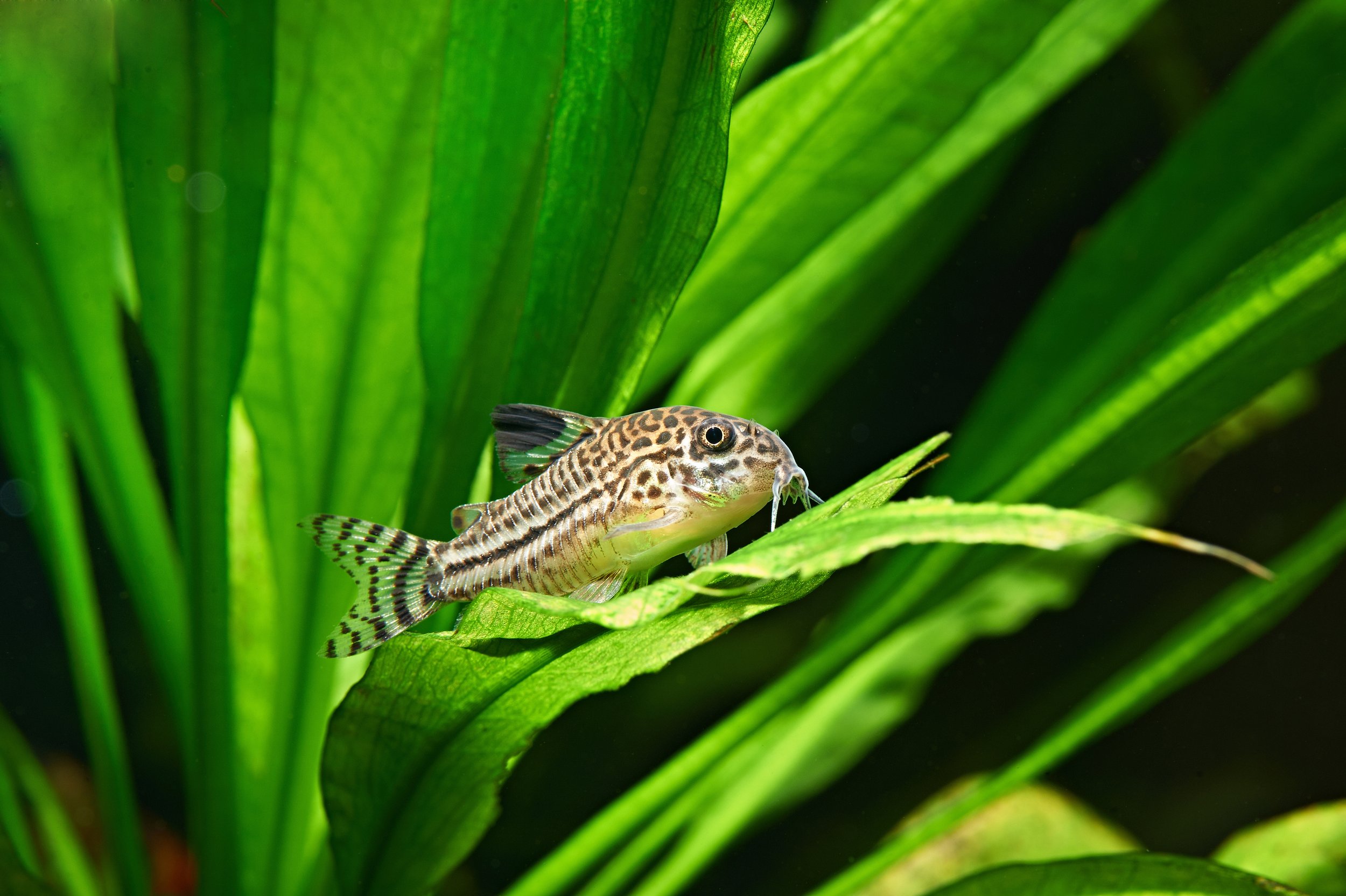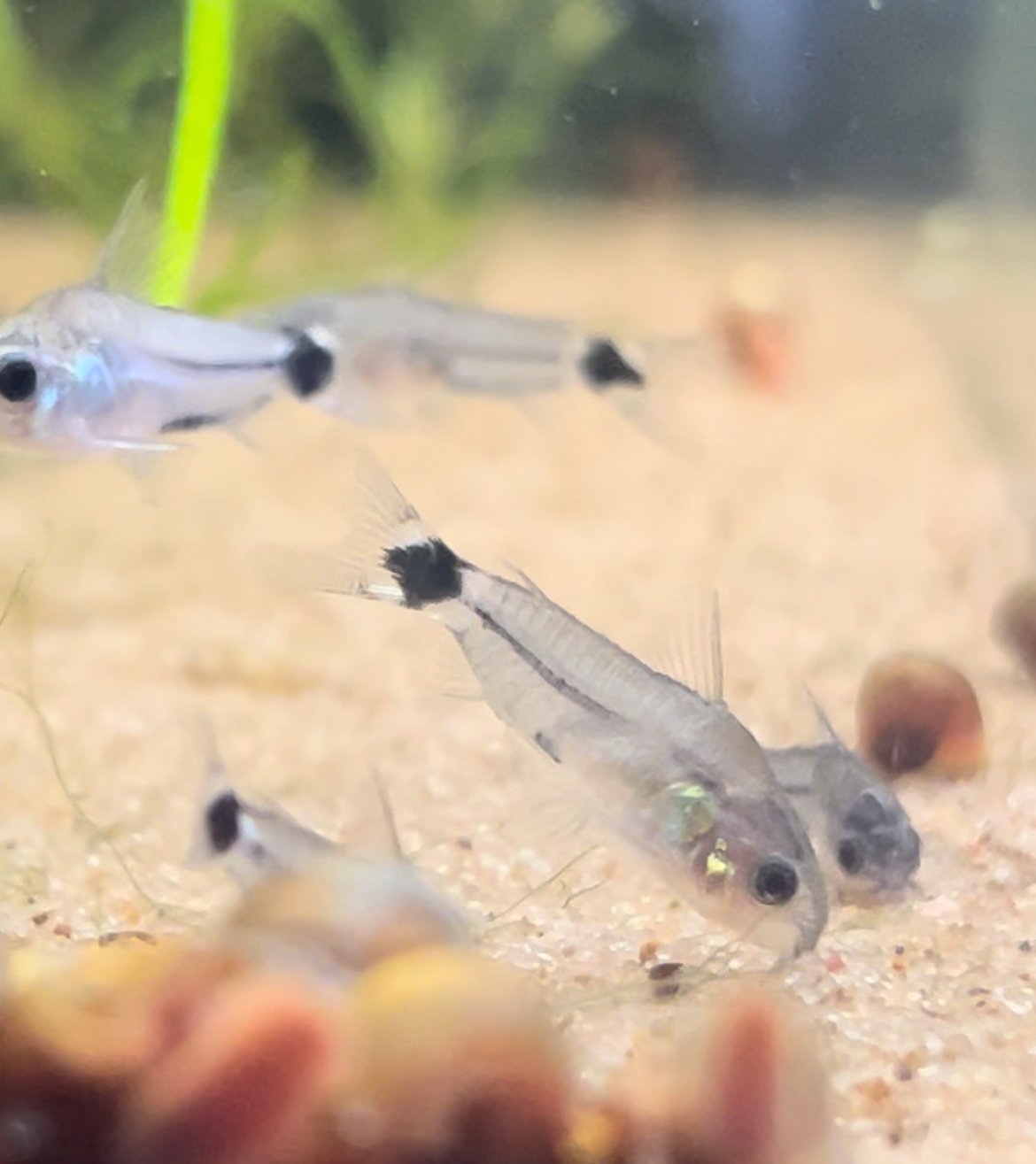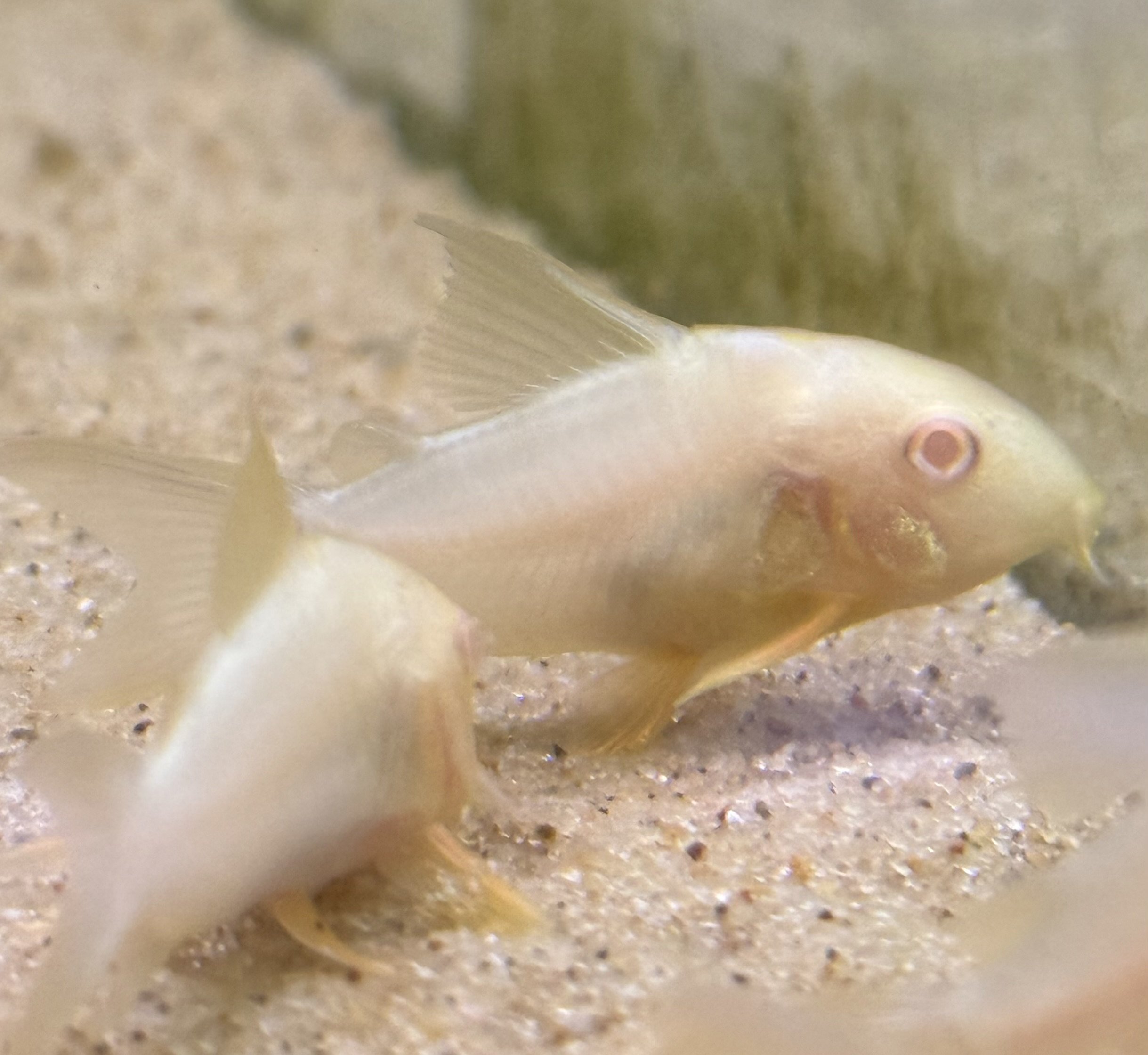 Image 1 of 3
Image 1 of 3

 Image 2 of 3
Image 2 of 3

 Image 3 of 3
Image 3 of 3




Julii Cory-L
The Julii Corydoras, scientifically known as Corydoras julii, is a peaceful and visually appealing freshwater catfish native to small rivers and tributaries in Brazil, specifically in the lower Amazon basin. Known for its striking spotted pattern and social nature, this species is a popular choice among aquarists seeking an active, bottom-dwelling fish to complement a community tank.
Physically, the Julii Corydoras is characterized by its silvery-white body covered with distinct, black spots and a network of fine, reticulated patterns. A black stripe runs horizontally from the snout through the eye, adding to its unique appearance. Unlike some similar species, such as the False Julii Cory (Corydoras trilineatus), the true Julii Cory has smaller, more defined spots that do not merge into reticulations on the head. Adults typically grow to about 2 to 2.5 inches (5 to 6 centimeters) in length.
In the aquarium, Julii Corydoras thrive in groups of at least six individuals, as they are highly social and exhibit natural behaviors when kept in shoals. A tank of at least 20 gallons is recommended, with a soft, sandy substrate to protect their sensitive barbels. Decorations like driftwood, rocks, and live plants provide hiding spots and create a natural environment. These fish are most active during the day but will also scavenge the substrate in search of food.
Water parameters for Julii Corydoras should replicate their natural habitat. They prefer soft, slightly acidic to neutral water with a pH range of 6.0 to 7.5 and temperatures between 72 to 78°F (22 to 26°C). Clean, well-oxygenated water is essential, so regular water changes and efficient filtration are crucial.
Feeding Julii Corydoras is straightforward, as they are omnivores and will accept a variety of foods. They thrive on sinking pellets or wafers designed for bottom-dwelling fish, supplemented with live or frozen foods like bloodworms, brine shrimp, and daphnia. They will also scavenge leftover food from the substrate, helping to keep the tank clean, though they should not be relied on solely for this purpose.
Julii Corydoras are peaceful and make excellent tank mates for other non-aggressive species. Suitable companions include tetras, rasboras, gouramis, and other small community fish. Avoid housing them with large or aggressive species that may outcompete them for food or pose a threat.
Breeding Julii Corydoras in captivity is possible with the right conditions. Spawning is typically triggered by slightly cooler water changes and the addition of high-protein foods. They are egg scatterers, and females will lay eggs on smooth surfaces like tank glass, plant leaves, or rocks. After spawning, the eggs should be removed to a separate tank to protect them from being eaten. The eggs hatch within 3 to 5 days, and the fry can be fed infusoria or powdered fry food until they are large enough to eat baby brine shrimp.
Overall, the Julii Corydoras (Corydoras julii) is a delightful and easy-to-care-for species that adds activity and charm to any freshwater aquarium. Their peaceful temperament, unique appearance, and bottom-dwelling habits make them a favorite among aquarists of all experience levels.
The Julii Corydoras, scientifically known as Corydoras julii, is a peaceful and visually appealing freshwater catfish native to small rivers and tributaries in Brazil, specifically in the lower Amazon basin. Known for its striking spotted pattern and social nature, this species is a popular choice among aquarists seeking an active, bottom-dwelling fish to complement a community tank.
Physically, the Julii Corydoras is characterized by its silvery-white body covered with distinct, black spots and a network of fine, reticulated patterns. A black stripe runs horizontally from the snout through the eye, adding to its unique appearance. Unlike some similar species, such as the False Julii Cory (Corydoras trilineatus), the true Julii Cory has smaller, more defined spots that do not merge into reticulations on the head. Adults typically grow to about 2 to 2.5 inches (5 to 6 centimeters) in length.
In the aquarium, Julii Corydoras thrive in groups of at least six individuals, as they are highly social and exhibit natural behaviors when kept in shoals. A tank of at least 20 gallons is recommended, with a soft, sandy substrate to protect their sensitive barbels. Decorations like driftwood, rocks, and live plants provide hiding spots and create a natural environment. These fish are most active during the day but will also scavenge the substrate in search of food.
Water parameters for Julii Corydoras should replicate their natural habitat. They prefer soft, slightly acidic to neutral water with a pH range of 6.0 to 7.5 and temperatures between 72 to 78°F (22 to 26°C). Clean, well-oxygenated water is essential, so regular water changes and efficient filtration are crucial.
Feeding Julii Corydoras is straightforward, as they are omnivores and will accept a variety of foods. They thrive on sinking pellets or wafers designed for bottom-dwelling fish, supplemented with live or frozen foods like bloodworms, brine shrimp, and daphnia. They will also scavenge leftover food from the substrate, helping to keep the tank clean, though they should not be relied on solely for this purpose.
Julii Corydoras are peaceful and make excellent tank mates for other non-aggressive species. Suitable companions include tetras, rasboras, gouramis, and other small community fish. Avoid housing them with large or aggressive species that may outcompete them for food or pose a threat.
Breeding Julii Corydoras in captivity is possible with the right conditions. Spawning is typically triggered by slightly cooler water changes and the addition of high-protein foods. They are egg scatterers, and females will lay eggs on smooth surfaces like tank glass, plant leaves, or rocks. After spawning, the eggs should be removed to a separate tank to protect them from being eaten. The eggs hatch within 3 to 5 days, and the fry can be fed infusoria or powdered fry food until they are large enough to eat baby brine shrimp.
Overall, the Julii Corydoras (Corydoras julii) is a delightful and easy-to-care-for species that adds activity and charm to any freshwater aquarium. Their peaceful temperament, unique appearance, and bottom-dwelling habits make them a favorite among aquarists of all experience levels.
The Julii Corydoras, scientifically known as Corydoras julii, is a peaceful and visually appealing freshwater catfish native to small rivers and tributaries in Brazil, specifically in the lower Amazon basin. Known for its striking spotted pattern and social nature, this species is a popular choice among aquarists seeking an active, bottom-dwelling fish to complement a community tank.
Physically, the Julii Corydoras is characterized by its silvery-white body covered with distinct, black spots and a network of fine, reticulated patterns. A black stripe runs horizontally from the snout through the eye, adding to its unique appearance. Unlike some similar species, such as the False Julii Cory (Corydoras trilineatus), the true Julii Cory has smaller, more defined spots that do not merge into reticulations on the head. Adults typically grow to about 2 to 2.5 inches (5 to 6 centimeters) in length.
In the aquarium, Julii Corydoras thrive in groups of at least six individuals, as they are highly social and exhibit natural behaviors when kept in shoals. A tank of at least 20 gallons is recommended, with a soft, sandy substrate to protect their sensitive barbels. Decorations like driftwood, rocks, and live plants provide hiding spots and create a natural environment. These fish are most active during the day but will also scavenge the substrate in search of food.
Water parameters for Julii Corydoras should replicate their natural habitat. They prefer soft, slightly acidic to neutral water with a pH range of 6.0 to 7.5 and temperatures between 72 to 78°F (22 to 26°C). Clean, well-oxygenated water is essential, so regular water changes and efficient filtration are crucial.
Feeding Julii Corydoras is straightforward, as they are omnivores and will accept a variety of foods. They thrive on sinking pellets or wafers designed for bottom-dwelling fish, supplemented with live or frozen foods like bloodworms, brine shrimp, and daphnia. They will also scavenge leftover food from the substrate, helping to keep the tank clean, though they should not be relied on solely for this purpose.
Julii Corydoras are peaceful and make excellent tank mates for other non-aggressive species. Suitable companions include tetras, rasboras, gouramis, and other small community fish. Avoid housing them with large or aggressive species that may outcompete them for food or pose a threat.
Breeding Julii Corydoras in captivity is possible with the right conditions. Spawning is typically triggered by slightly cooler water changes and the addition of high-protein foods. They are egg scatterers, and females will lay eggs on smooth surfaces like tank glass, plant leaves, or rocks. After spawning, the eggs should be removed to a separate tank to protect them from being eaten. The eggs hatch within 3 to 5 days, and the fry can be fed infusoria or powdered fry food until they are large enough to eat baby brine shrimp.
Overall, the Julii Corydoras (Corydoras julii) is a delightful and easy-to-care-for species that adds activity and charm to any freshwater aquarium. Their peaceful temperament, unique appearance, and bottom-dwelling habits make them a favorite among aquarists of all experience levels.






